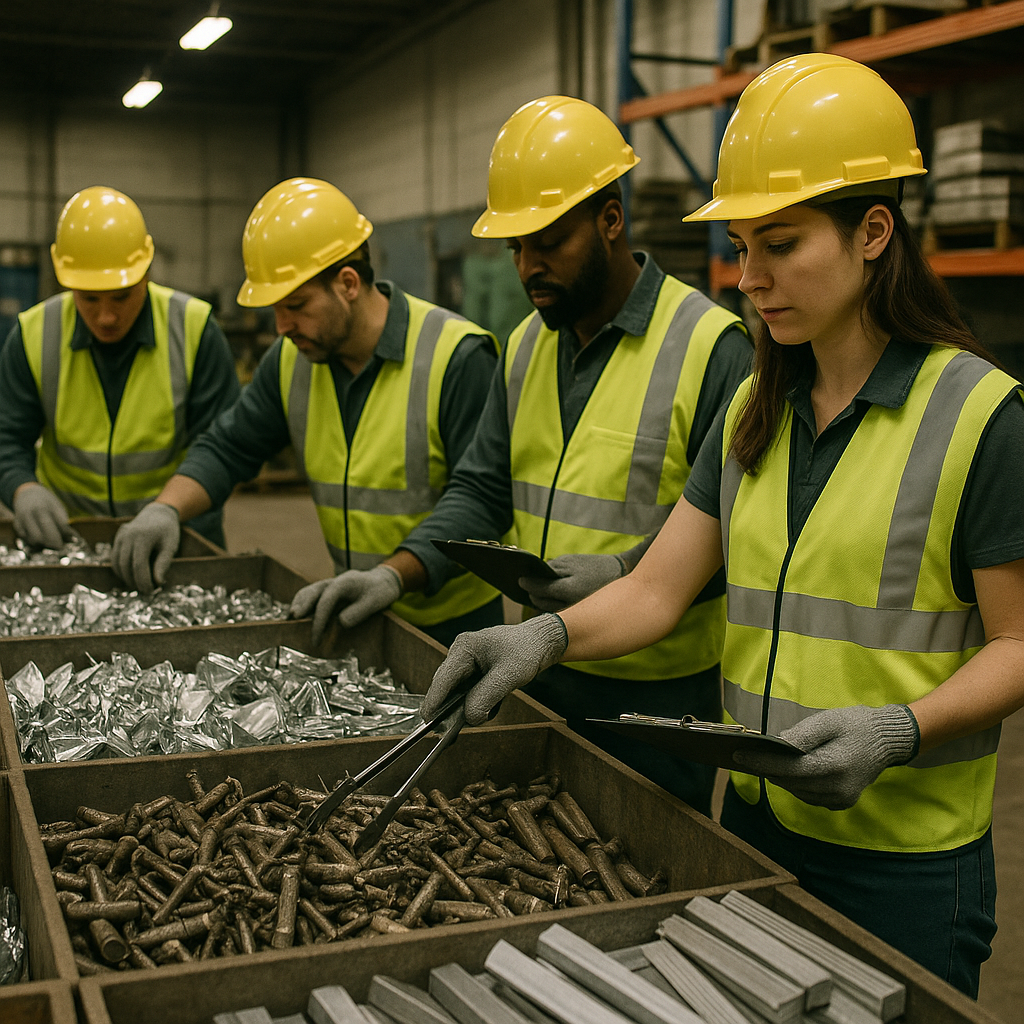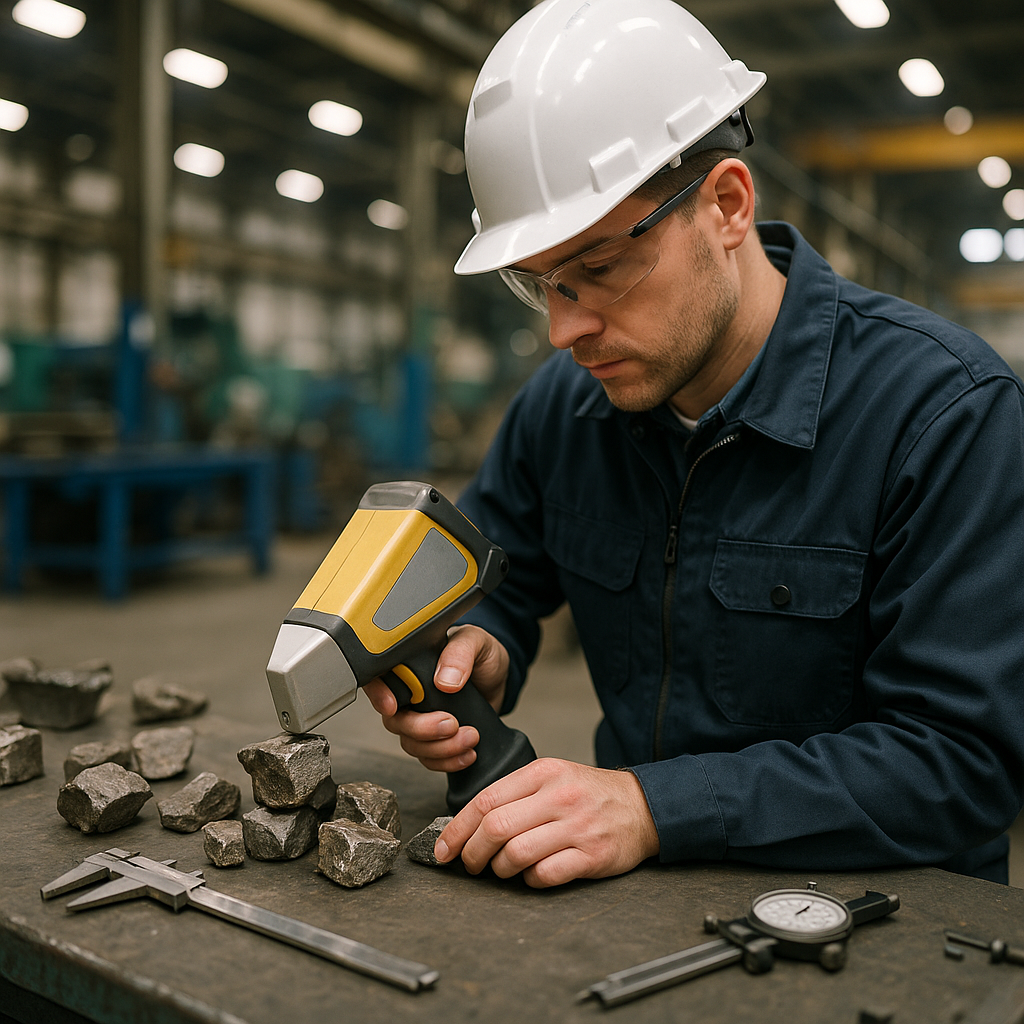5901 Botham Jean Blvd, Dallas, TX 75215
Scrap Metal Inspection and Grading Process: Everything You Need to Know
October 7, 2025The scrap metal inspection and grading process is a systematic evaluation of recycled metal materials to determine their quality, value, and suitability for reuse. This critical first step in the recycling chain transforms what might appear to be random metal waste into properly categorized resources ready for processing.
At its core, the process involves examining metal scrap through visual assessment and technological analysis to identify its composition, purity levels, and potential contaminants. Metal recyclers use various methods, from simple magnetic tests that separate ferrous from non-ferrous materials to sophisticated spectroscopic analysis that determines precise chemical makeup.
The grading outcome directly influences the material’s market value and future application in manufacturing. With steel recycling rates exceeding 80 million tons annually in North America alone, these classification systems ensure that the right scrap reaches the appropriate production facilities, supporting a circular economy while conserving valuable resources and energy.
How are Different Types of Scrap Metals Identified and Sorted?

Scrap metals fall into two primary categories: ferrous metals, which contain iron, and non-ferrous metals, which don’t. Accurate identification and sorting of these metals are crucial for recycling facilities to maximize value and ensure proper processing. Several methods exist for this identification, ranging from simple manual techniques to advanced technological solutions.
The Magnet Test: A Simple Yet Effective Method
The most basic and accessible method for identifying scrap metals is the magnet test. This straightforward technique helps recyclers quickly separate ferrous from non-ferrous metals. When a magnet is placed near ferrous metals like steel or cast iron, it strongly attracts them. Non-ferrous metals such as aluminum, copper, and brass show no magnetic attraction.
This method serves as the first step in the sorting process at most recycling facilities. It allows workers to rapidly process large volumes of mixed scrap and create an initial separation that forms the foundation for more refined sorting techniques.
Visual Identification Techniques
Experienced recyclers often develop the ability to identify different metals by their appearance. Copper has a distinctive reddish-brown color, while aluminum appears silvery white and lightweight. Brass displays a yellowish hue, and stainless steel typically has a shiny silver finish.
For metals with surface contamination, recyclers might use a metal file to scrape away the outer layer. This reveals the true color and texture beneath any coatings or oxidation, providing valuable clues about the metal’s identity.
Advanced Technological Solutions
For precise identification of metal composition and grades, recycling facilities employ sophisticated technological tools:
X-ray fluorescence (XRF) analyzers have become essential equipment in modern scrap yards. These devices emit X-rays onto the metal sample, causing the atoms to emit characteristic X-rays that identify the elements present. Handheld XRF analyzers can determine the exact chemical composition of scrap metal in seconds, detecting both major components and trace elements. This technology helps recyclers sort materials with nearly identical appearances but different compositions.
Optical emission spectrometry (OES) offers another advanced identification method. This technique analyzes the spectrum of light emitted when a metal sample is heated to extremely high temperatures. Each element produces a unique spectral pattern, allowing for precise identification of the metal’s composition.
Sorting Process in Recycling Facilities
In professional recycling operations, the sorting process typically follows these steps:
First, large pieces of scrap metal are separated manually based on visual identification. Next, magnets extract ferrous materials from the mixture. The remaining non-ferrous metals undergo more detailed analysis using XRF or OES technology to determine their exact composition. Finally, metals are sorted into specific categories based on type and grade before being processed further.
Proper preparation of scrap materials enhances sorting accuracy. Recyclers remove coatings, paint, or contaminants that might interfere with identification. They avoid testing materials covered in oil or grease, as these substances can lead to false readings and potentially damage testing equipment.
Importance of Accurate Sorting
Accurate identification and sorting of scrap metals deliver significant benefits. Properly sorted metals command higher prices, maximizing the value of recycled materials. It ensures that metals go through the appropriate recycling processes, optimizing resource recovery. It prevents contamination issues that could compromise the quality of recycled products.
As technology advances, sorting methods continue to become more sophisticated and efficient. Many recycling facilities now implement automated sorting systems that combine various technologies to process large volumes of scrap metal with minimal human intervention, further improving accuracy and throughput.
What Equipment is Used in Scrap Metal Inspection?

The scrap metal recycling industry relies on advanced analytical tools to accurately identify, grade, and value materials. Modern inspection equipment enables recycling facilities to sort metals quickly and precisely, maximizing both efficiency and profitability.
Handheld XRF Analyzers
X-ray fluorescence (XRF) analyzers have become essential tools in scrap metal yards worldwide. These portable devices direct X-rays at metal surfaces, causing atoms to emit fluorescent X-rays with unique elemental signatures. Within seconds, the analyzer identifies the metal’s composition.
XRF analyzers excel at identifying heavy metals and distinguishing between similar alloys, such as different grades of stainless steel. They provide non-destructive testing with minimal sample preparation, making them ideal for high-volume operations where speed is crucial.
The latest XRF models feature silicon drift detectors (SDD) and advanced software that can identify materials in as little as 3-5 seconds. This technology allows recyclers to process more material while maintaining accuracy, especially for separating valuable non-ferrous metals.
LIBS Technology
Laser-Induced Breakdown Spectroscopy (LIBS) offers complementary capabilities to XRF analysis. LIBS devices use a high-energy laser pulse to create a plasma on the material’s surface. As the plasma cools, it emits light at wavelengths characteristic of the elements present.
LIBS technology provides significant advantages when analyzing lighter elements like carbon, magnesium, and aluminum. This makes LIBS particularly valuable for sorting aluminum alloys and low-carbon steels, where small composition variations dramatically affect value.
For recycling facilities handling automotive scrap, LIBS analyzers help identify different grades of steel based on carbon content, ensuring proper sorting and maximizing material value.
Optical Emission Spectrometers
When the highest level of precision is required, optical emission spectrometry (OES) delivers laboratory-grade analysis. These instruments excite atoms in the metal sample using an electrical arc or spark, causing them to emit light at wavelengths specific to each element.
OES technology offers superior accuracy in detecting trace elements and light elements like carbon, phosphorus, and sulfur. This is invaluable for quality control in high-grade metal recycling and foundry operations where exact specifications must be met.
While less portable than XRF or LIBS devices, modern OES systems provide detailed bulk composition analysis to help recyclers verify material quality before shipment to mills and foundries.
Combining Technologies for Optimal Results
Many advanced recycling operations utilize multiple analytical technologies. XRF analyzers might handle initial sorting, while LIBS devices verify carbon content in steel alloys. Final quality assurance could involve OES testing for precise composition verification.
This multi-technology approach allows recyclers to process materials efficiently while meeting strict quality standards. The right combination depends on the specific metals being processed and customer requirements.
| Technology | Advantages | Limitations | Applications |
|---|---|---|---|
| X-ray Fluorescence (XRF) | Non-destructive; Fast results; Easy to use; Accurate for heavier elements | Limited detection of light elements; Surface sensitivity | Scrap metal sorting; Manufacturing quality control; Mining |
| Laser-Induced Breakdown Spectroscopy (LIBS) | Rapid analysis; Detects light elements; Portable | Potential for surface damage; Calibration challenges | On-site metal sorting; Alloy verification; Aerospace and automotive manufacturing |
| Optical Emission Spectrometry (OES) | Highly precise; Comprehensive elemental analysis | Sample preparation required; Not portable; Higher cost | High-grade metal recycling; Alloy production; Industrial quality control |
As metal recycling technology evolves, these analytical instruments become more portable, durable, and user-friendly. The result is more efficient operations that recover higher-value materials while reducing contamination in the recycling stream.
How Does the Grading Process Impact Scrap Metal Value?

The grading process is crucial in determining the market value of scrap metal. Recyclers who classify materials based on composition, purity, and quality can unlock their true economic potential. Higher grades consistently fetch premium prices because they require less processing and offer greater value to manufacturers.
Metal purity significantly affects pricing throughout the recycling supply chain. For example, clean copper wire without insulation (known as bare bright copper) can command 15-30% more than copper with contaminants or coatings. Similarly, clean aluminum without paint or attachments is valued higher than contaminated versions. These price differences provide strong financial incentives for thorough sorting and proper grading.
Several key factors determine how grading impacts scrap metal value:
- Metal type classification – Non-ferrous metals like copper, aluminum, and brass usually command higher prices than ferrous metals like steel and iron due to their properties and diverse applications.
- Contaminant levels – The presence of paint, oil, dirt, plastic, or mixed alloys significantly reduces value as they require additional processing to remove.
- Material consistency – Uniform loads of consistently graded material receive better pricing than mixed loads needing additional sorting.
- Processing requirements – Pre-processed materials (shredded, baled, or properly sized) often receive higher prices as they require less handling by recyclers.
- Certification documentation – Properly documented materials with verifiable grading certificates may qualify for premium prices in certain markets.
Accurate grading provides transparency and builds trust within the recycling ecosystem. When recyclers implement standardized grading practices with clear documentation, they create price visibility and ensure fair compensation. This structured approach reduces disputes about material quality and supports more stable pricing models.
Advanced grading technologies are transforming the industry, enhancing accuracy and efficiency. X-ray fluorescence analyzers can instantly determine metal composition, while automated sorting systems using artificial intelligence can process hundreds of pieces per minute with over 90% accuracy. These innovations not only improve grading precision but also increase processing throughput, creating additional value for recyclers.
For businesses generating significant scrap metal, investing in proper grading protocols directly affects the bottom line. Training staff to identify and separate different metal grades, implementing pre-processing steps like removing contaminants, and maintaining detailed documentation can significantly increase revenue from recycling operations. Even small improvements in grading accuracy can yield substantial financial benefits when applied consistently over large volumes of material.
The economic impact of effective grading extends beyond immediate pricing benefits. Properly graded metals enter more efficient recycling streams, reducing energy consumption and processing costs throughout the supply chain. This efficiency translates into more stable markets and sustainable value for all participants in the metal recycling ecosystem.
| Metal Type | Grade | Price |
| Circuit Board | High Grade | $3.25/lb |
| Circuit Board | Mid Grade | $0.90/lb |
| Circuit Board | Low Grade | $0.20/lb |
| Circuit Board | Low Grade | $0.25/lb |
| Motherboard | Clean Green (With CPU) | $1.30/lb |
| Motherboard | Clean Green (Without CPU) | $0.75/lb |
Conclusion: The Importance of Accurate Scrap Metal Inspection and Grading

Accurate inspection and grading of scrap metal form the foundation of an efficient and profitable recycling industry. Proper identification, sorting, and valuation of materials enable recycling facilities to process them more effectively, maximizing environmental and economic benefits. Precise grading ensures that metals are directed to their most suitable applications, supporting the development of high-quality recycled products while maintaining the integrity of manufacturing processes.
Meticulous inspection of scrap metal offers significant sustainability advantages. By decreasing the need for virgin material extraction, we conserve valuable natural resources and substantially reduce the environmental impact of metal production. The energy savings are notable—recycling aluminum uses 95% less energy than producing it from raw bauxite ore, while recycling steel reduces CO2 emissions by about 58% compared to primary production. These efficiency gains result in fewer greenhouse gas emissions, reduced water use, and decreased land disruption from mining.
As global demand for metals rises amid increasing resource scarcity, the role of accurate scrap metal inspection and grading is crucial to building a resilient circular economy. The future of sustainable metal production hinges on our ability to identify, sort, and value these materials—transforming what was once waste into valuable resources that can be recycled indefinitely without quality loss. For assistance with your metal recycling needs and to learn more about maximizing the value of your scrap through proper grading techniques, contact Okon Recycling at 214-717-4083.
